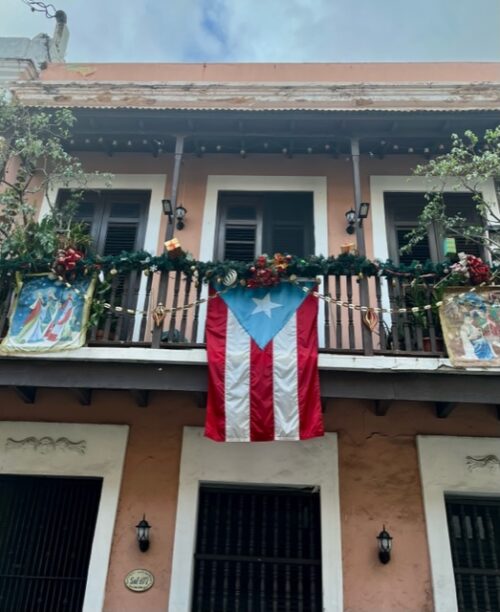by Michael Traynor

Real estate is about location, and the Spanish Conquistadors knew a good location when they saw one. They thought it was paradise, but mostly because San Juan and its harbor were the perfect place to build and defend a New World empire. Puerto Rico is the first land mass encountered between Europe and the Caribbean/South America. San Juan was built to be the principal fortress city guarding the flow of wealth between Old and New Worlds — and as a bonus, its location is stunningly beautiful — paradise!
Five hundred years later, the remnants of their empire are on display for hordes of tourists that disgorge daily from cruise ships larger than anything the Conquistadors could have imagined. It’s still a stunningly beautiful location and it remains a paradise for different reasons than those held by the conquistadors.
What do modern tourists encounter? Observable signs of human presence start in the early 1500’s, as the local Taino people and their cultural record were thoroughly annihilated. In their place stand the most massive fortifications built in the New World, never breached by the many invading forces that tried. The remnants of these walls and the Hispanic culture they protected remain mostly intact. The islands’ stunning natural beauty, colorful buildings and welcoming climate provide a picturesque context for tourists to exchange their money for locally branded San Juan trinkets — many uncomfortably marked made in China! The active tourist economy also services local expatriate communities, many affluent and many being retirees. This is the new paradise.
Every paradise must have its serpent. Puerto Rico’s serpent is the interconnected ills besetting most every Caribbean society. People overwhelmingly remain poor and intractably so; services are limited; infrastructure is weak; economic opportunity is limited; and debt burdens are heavy. Pandemic closures have exacerbated societal ills, and it seems global warming has made harsh hurricane seasons more damaging. Infrastructure is struggling to keep pace as the capacity to maintain it weakens. All this is visible, if we choose to look at it.
San Juan is like a Garden of Eden, serpent and all. To appreciate the place more fully, it may help to understand both its attractive and troubling aspects. The additional perspectives you gain could even be like having sampled fruit from The Tree of the Knowledge of Good and Evil. If so, that would be positively biblical!
Here are some touristy shots of San Juan! The city is a diverse place, and for more, visit and experience it fully yourself!

Fierce trade winds like these brought the conquistadors to these shores, and formed the reason they chose to stay in such numbers

Protected beach areas, once safe harbors for ships, now fill up with sunbathers

These iconically shaped guard towers are strategically interspersed amidst cannon emplacements behind fortress walls surrounding the city

The San Juan Gate (in red) was the official port of entry and welcome for dignitaries arriving from abroad, who then proceeded straight ahead to the main cathedral to offer their thanks for a safe arrival

The San Juan Cathedral features the saint’s statue, here appearing to be descending from heaven at sunrise

Cobblestone streets are narrow, winding, tree lined and cramped — as everything needed to fit within tight walls

Hidden garden courtyards, inaccessible from the street, provided serenity and respite apart from the bustle of the city beyond

The oldest cemetery on the island lies immediately outside the walls facing the ocean. Since the conquistadors could not conquer death, they had to settle for unobstructed ocean views

An old, poor community outside the walls. Grinding poverty, even in paradise, is still poverty

Just plain fun. Pigeon Park. Its denizens reside in nearby rock hewn cubicles and are fed by locals and tourists alike






